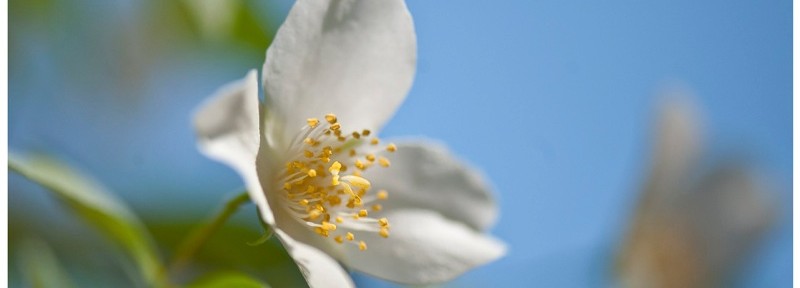 Philadelphus coronarious – Mock Orange or English Dogwood
Philadelphus coronarious – Mock Orange or English Dogwood
Berceuse In D Flat Major, Op
It certainly feels like springtime outside. Many garden plants have broken dormancy, and the botanical world around East Texas is stirring with the warm weather. Ah, spring… One of the plants stirring in my garden is the Mock Orange or English Dogwood (Philadelphus coronarius). This is one of my favorite shrubs. They are in full bloom. The flowering of the Philadelphus is one of spring’s great performances. It has bloomed, as expected, in late April when the warm weather awakens this elegant plant from her winter slumbers. The Mock Orange has been in wide cultivation in the South for well over a hundred years. This shrub has a fountain-like form and can easily grow to a height of 6ft. and a width of 5ft. It is a worthy plant in any Southern garden that achieves great beauty with seemingly little effort. I’m surprised it’s so neglected. This is often the case for our best garden plants. If a plant does well and thrives with little fuss or attention from the gardener, we foolishly consider it common, ordinary, or “ho-hum”. But I think we should think about this superb garden plant in a different way. Have you ever seen an artist paint, a musician perform, a poet give a reading, or an athlete compete? The very best make what they do seem easy. It’s only an illusion. What they achieve is actually priceless and magnificent, well out of the capability of the general public. This is the case with the Philadelphus.
Here in East Texas, this plant performs like a professional, producing elegant, blooms in great sweeps of classic white. What makes this plant especially beautiful when it blooms is that it blooms about the time it puts on its new foliage every spring. The pale light green color of the early spring foliage set off by the clear, white blooms is a sight to behold. I don’t necessarily think that to praise one plant one needs to put down others, but East Texas gardeners worry and fret over their Dogwood trees. Year in and year out, horticulturalists get calls about sick Dogwood trees. Now I truly like our East Texas Dogwood, and I’m not putting it down, but the Philadelphus can stand on its own in any competition with any flowering tree even with our native Dogwoods. The Philadelphus is one of the domestic plants that I would not want to be without. I have said it before; this plant is one of our Southern aristocrats. Its aristocratic and elegant nature belies this plant’s very tough nature. Here in East Texas it has few diseases, does not mind our hot weather, needs minimal irrigation (although it’s happy for an extra drink during dry spells), can be grown in sunlight or light shade and is generally a plant we take for granted until it awakens from its winter sleep and comes into bloom, creating a botanical composition of white on green equal in beauty to any of the world’s great musical composers. Chopin’s Berceuse in D Flat Major, Op. 57 comes to mind. As my Philadelphus blooms this spring I’ve opened the windows, played this tranquil piece of music, and enjoyed them both. It’s a perfect way to spend a lazy, spring morning.
This leads me to the one criticism of the Philadelphus. Its bloom period is relatively short just like Chopin’s elegant little piece, but this is no real criticism. We don’t criticize a sunset for lasting just a moment; we just savor it. Remember Michael Jordan’s magnificent feats on the basketball court; they were a mere flash in sports history, but everyone that saw them knew they were in the presence of something very special. The short two and a half week bloom of the Philadelphus is equally special.
As I watch Philadelphus coming out of its winter slumber to perform its elegant little composition of clear white and delicate green I’m grateful to be around for the performance.
